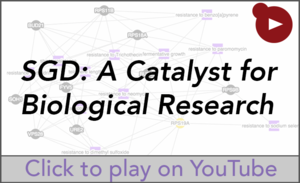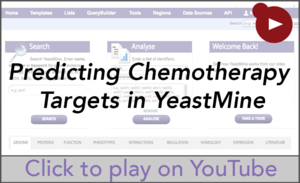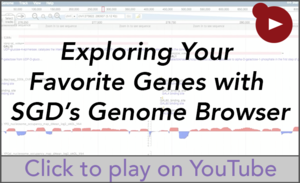Difference between revisions of "SGD Webinar Series"
(→Previous Webinars) |
(→Previous Webinars) |
||
| Line 16: | Line 16: | ||
| − | [[File: | + | [[File:SGD-webinars-youtube-2.png|300px||link=https://www.youtube.com/watch?v=-Qefg1gm7ho]] |
===May 4, 2016 – Predicting Chemotherapy Targets in YeastMine=== | ===May 4, 2016 – Predicting Chemotherapy Targets in YeastMine=== | ||
If you’re not already using YeastMine to answer all your questions about ''S. cerevisiae'' genes and gene products… you should be! SGD's YeastMine is a powerful search tool that can retrieve, compare, and analyze data on thousands of genes at a time, greatly reducing the time needed to answer practical research questions. Through YeastMine, questions such as "What proportion of plasma membrane proteins are essential?" or "How many different gene products physically interact with the mitochondrial ribosome?" can be answered within minutes. This short webinar provides a brief tutorial on how to run queries and save gene lists in YeastMine, and demonstrates a research scenario where yeast-human homology data is used to predict potential chemotherapy targets. | If you’re not already using YeastMine to answer all your questions about ''S. cerevisiae'' genes and gene products… you should be! SGD's YeastMine is a powerful search tool that can retrieve, compare, and analyze data on thousands of genes at a time, greatly reducing the time needed to answer practical research questions. Through YeastMine, questions such as "What proportion of plasma membrane proteins are essential?" or "How many different gene products physically interact with the mitochondrial ribosome?" can be answered within minutes. This short webinar provides a brief tutorial on how to run queries and save gene lists in YeastMine, and demonstrates a research scenario where yeast-human homology data is used to predict potential chemotherapy targets. | ||
Revision as of 10:00, 3 June 2016
About the SGD Webinar Series:
The SGD Webinar Series is a series of interactive webcasts aimed at demonstrating the SGD website and the value of yeast as a model organism. Information about previous and upcoming webinars can be found on this page or at the SGD newsfeed (http://www.yeastgenome.org/blog). Video recordings of previous webinars are always uploaded at the SGD YouTube channel (https://www.youtube.com/SaccharomycesGenomeDatabase)
Contents
Upcoming Webinars
Next in the SGD Webinar Series: Details Coming Soon
July 6th, 2016 – 9:30 AM PDT
More information on our upcoming webinar next month on July 6th coming soon – stay tuned!
Previous Webinars
April 6, 2016 – SGD: A Catalyst for Biological Research
Function is just one of many important angles to consider a gene and its product. Other concepts like regulation, genetic/physical interactions, phenotypes, are critical to understanding how a gene fits into the overall biology of the cell. By quickly connecting users to high-quality annotations, different types of data, and useful tools to explore the yeast genome, SGD acts as a catalyst for biological research and has become an indispensable resource for many scientists. This short webinar provides an overview of the different ways you can find information about your favorite genes in SGD.
May 4, 2016 – Predicting Chemotherapy Targets in YeastMine
If you’re not already using YeastMine to answer all your questions about S. cerevisiae genes and gene products… you should be! SGD's YeastMine is a powerful search tool that can retrieve, compare, and analyze data on thousands of genes at a time, greatly reducing the time needed to answer practical research questions. Through YeastMine, questions such as "What proportion of plasma membrane proteins are essential?" or "How many different gene products physically interact with the mitochondrial ribosome?" can be answered within minutes. This short webinar provides a brief tutorial on how to run queries and save gene lists in YeastMine, and demonstrates a research scenario where yeast-human homology data is used to predict potential chemotherapy targets.
- For reference, the list of human tumor suppressors that was analyzed during the webinar is provided here: File:TSGene-LOFdataset.xlsx
June 1, 2016 – Exploring Your Favorite Genes with SGD's Genome Browser
SGD's JBrowse is a quick and easy way to browse through the information-rich yeast genome. Using JBrowse, you can visualize spatial relationships between genes, locate SGD annotations throughout the yeast genome, and compare chromosomal features to hundreds of experimental data sets. This short webinar demonstrates how to navigate the genome with JBrowse, locate your favorite genes or chromosomal features, and visualize experimental data with data tracks. Whether you're an experienced GBrowse user looking to try JBrowse for the first time or someone new to genome browsing as a whole, this webinar is sure to help you get started.



